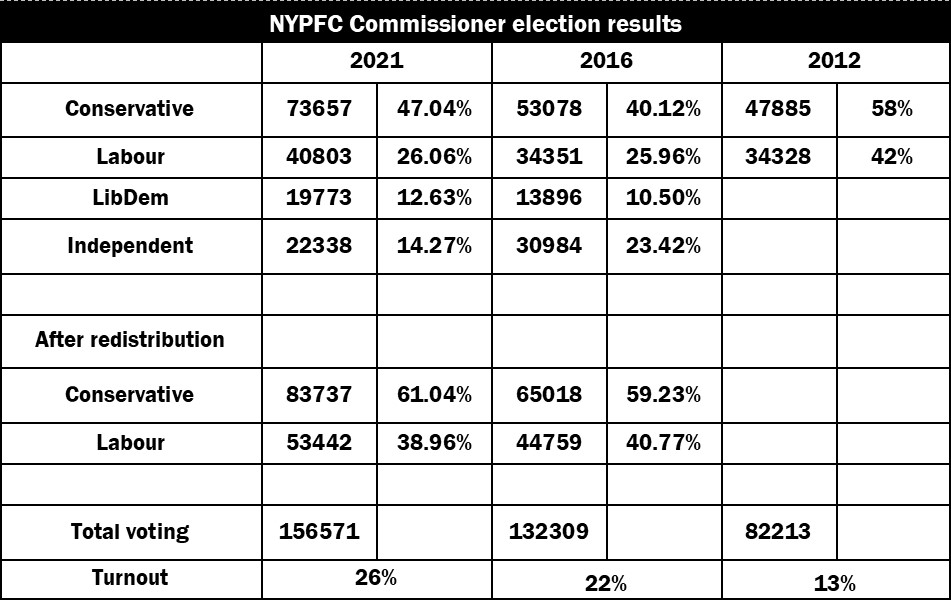Deaths
No further hospital deaths have been announced
Test results
Six additional positive test results today bring total up to 12,303.
Citywide case numbers reduce by two to 37.
Rate /100k population falls to 17.57. Trend is still downwards
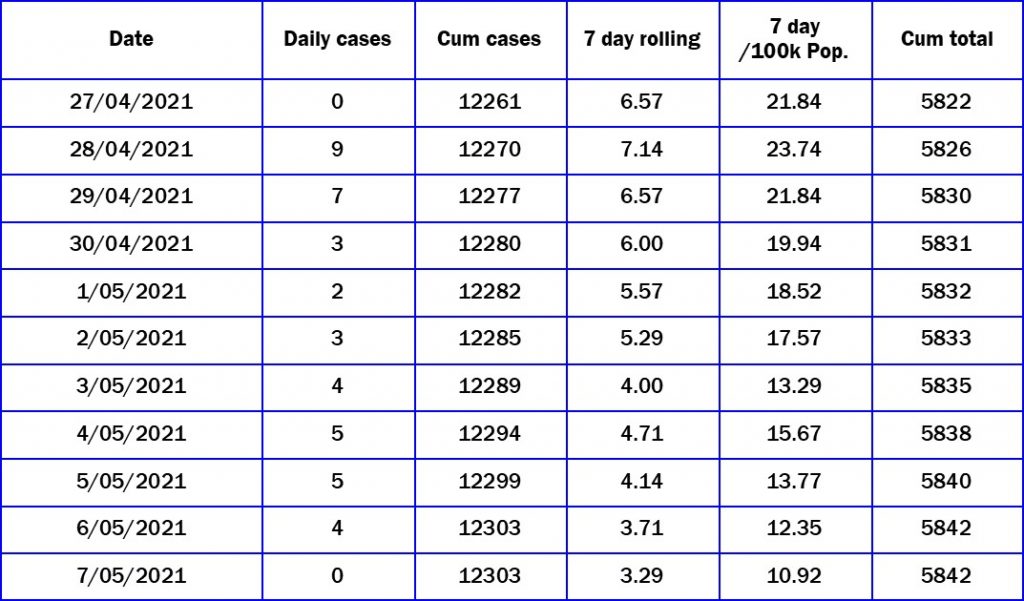
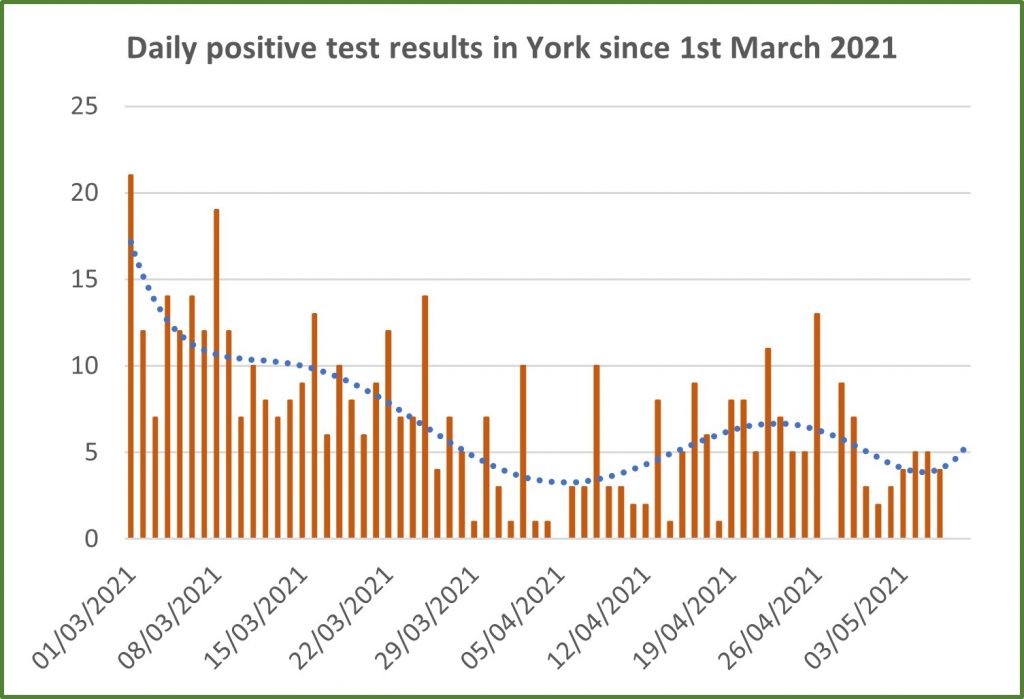
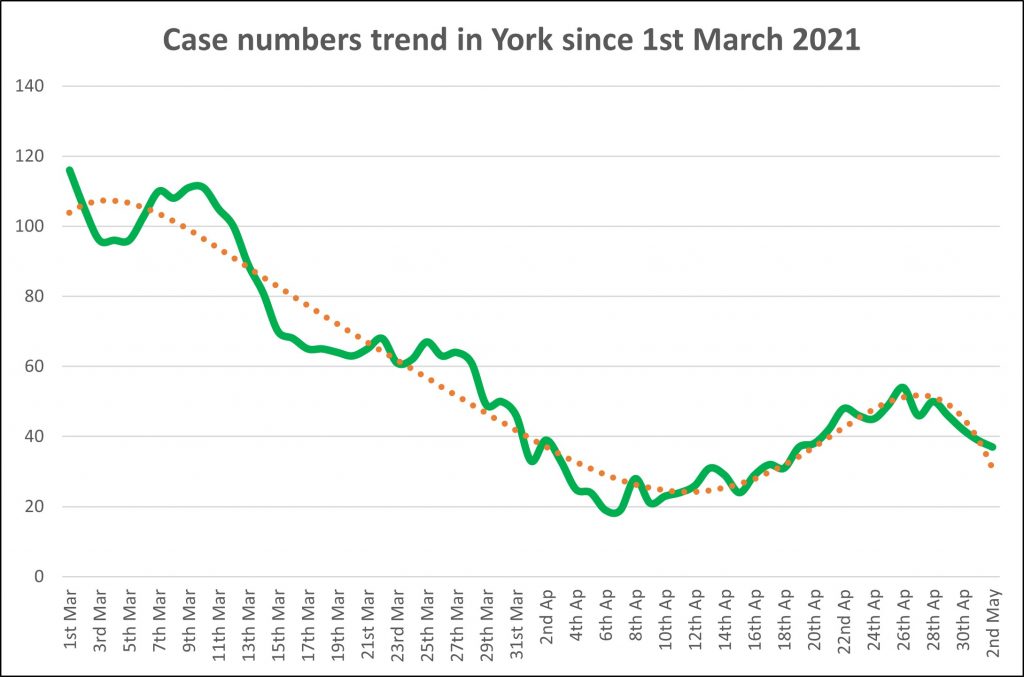
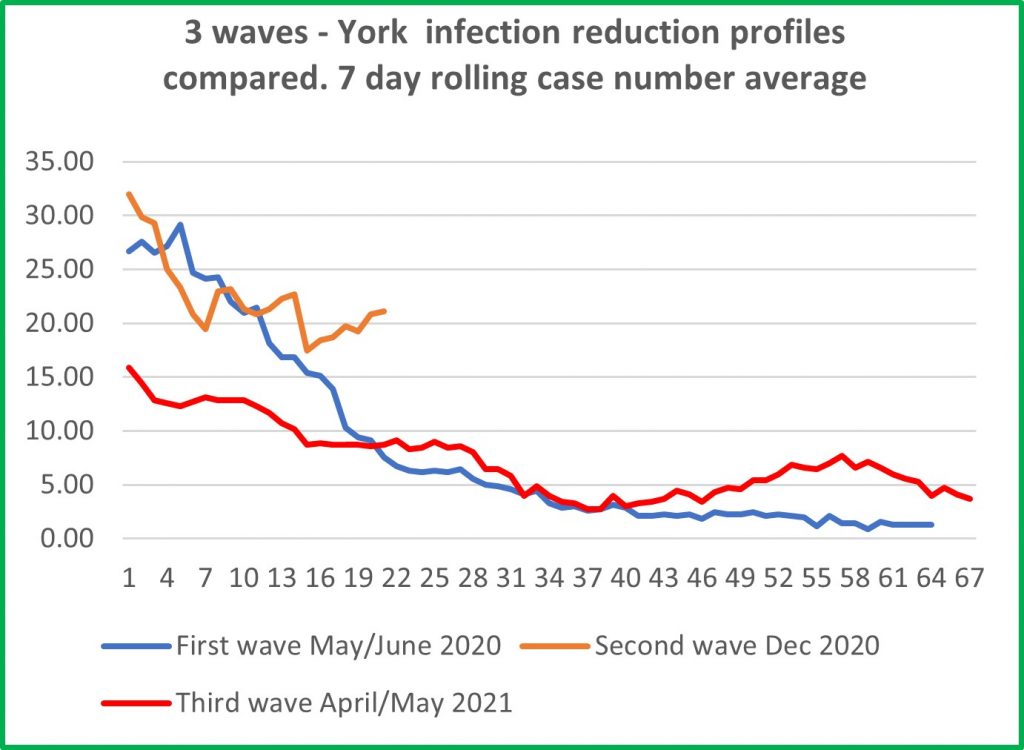
Infection rates continue to fall at all levels
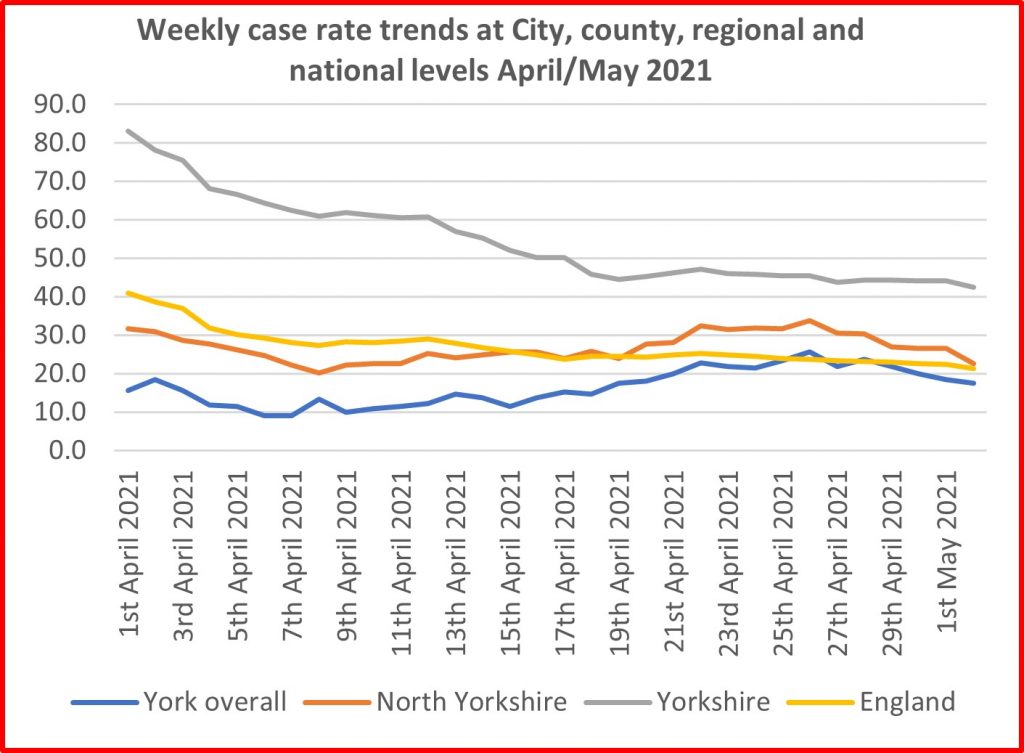
Neighbourhoods
No major changes at neighbourhood level.
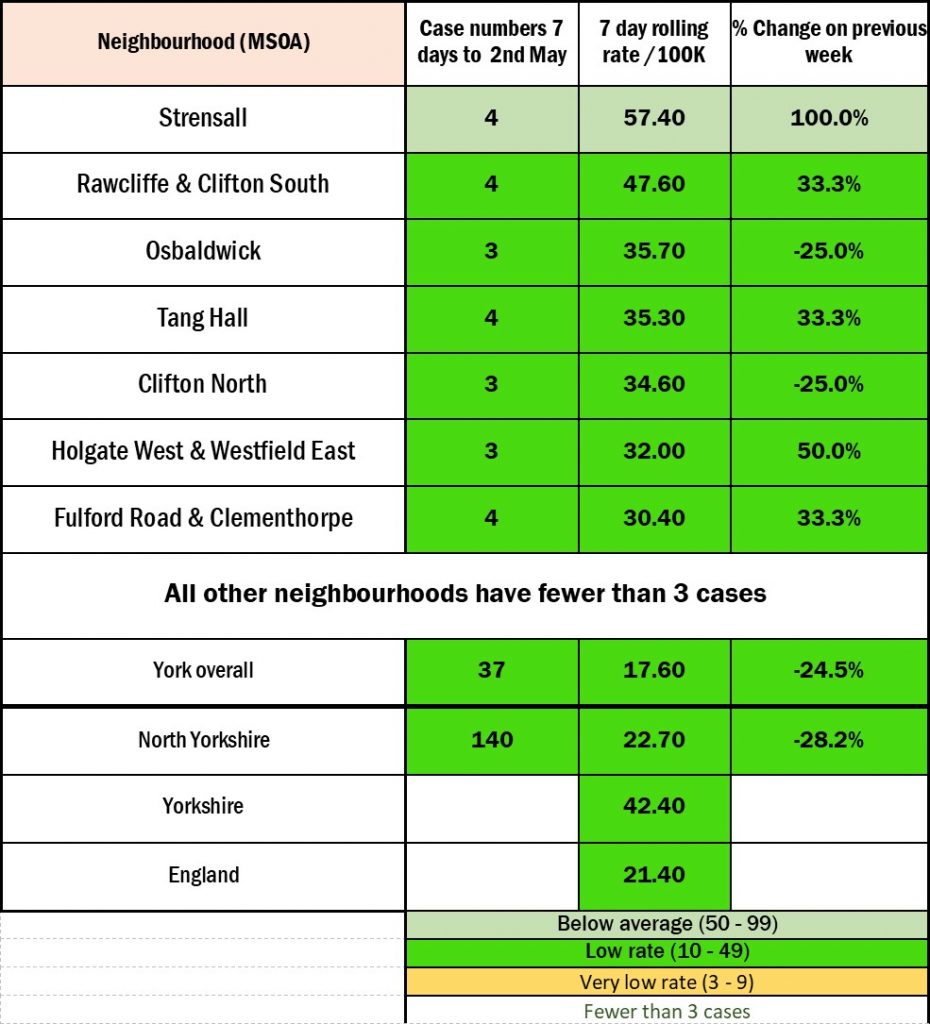
Vaccinations
- As at 5/5/21, 58.8% of York’s adult population have now had their first vaccination .
- 28.7% have also received their second vaccination
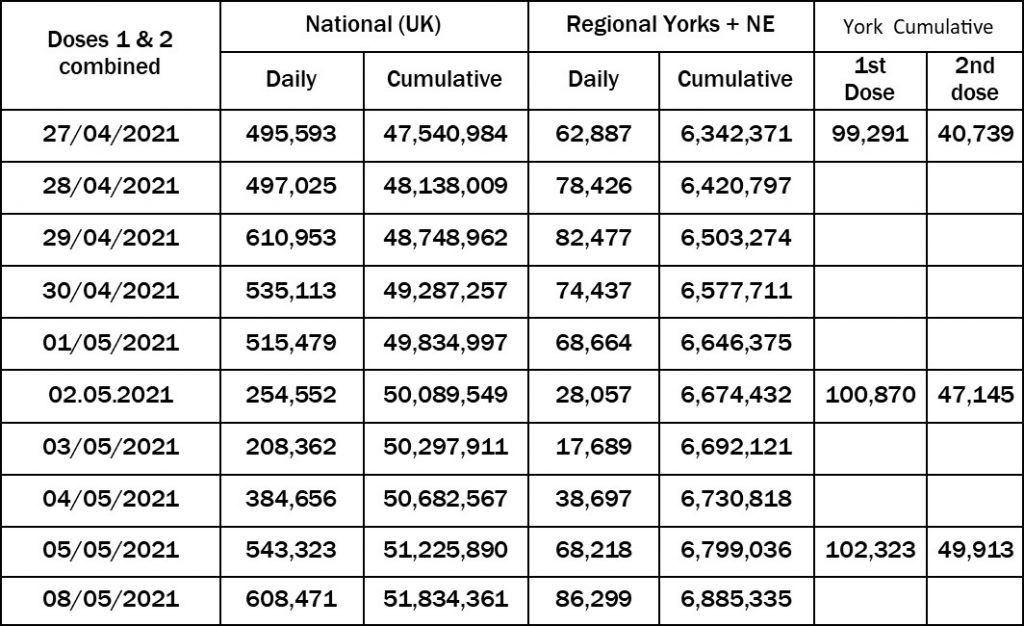
Tests
- 4330 PCR tests were conducted in York during the week ending 2nd May 2021
- Of these, 0.8% were positive. This was an increase on the previous days figure of 0.7%
- In addition, 2880 “lateral flow” tests were also carried out.
Hospital
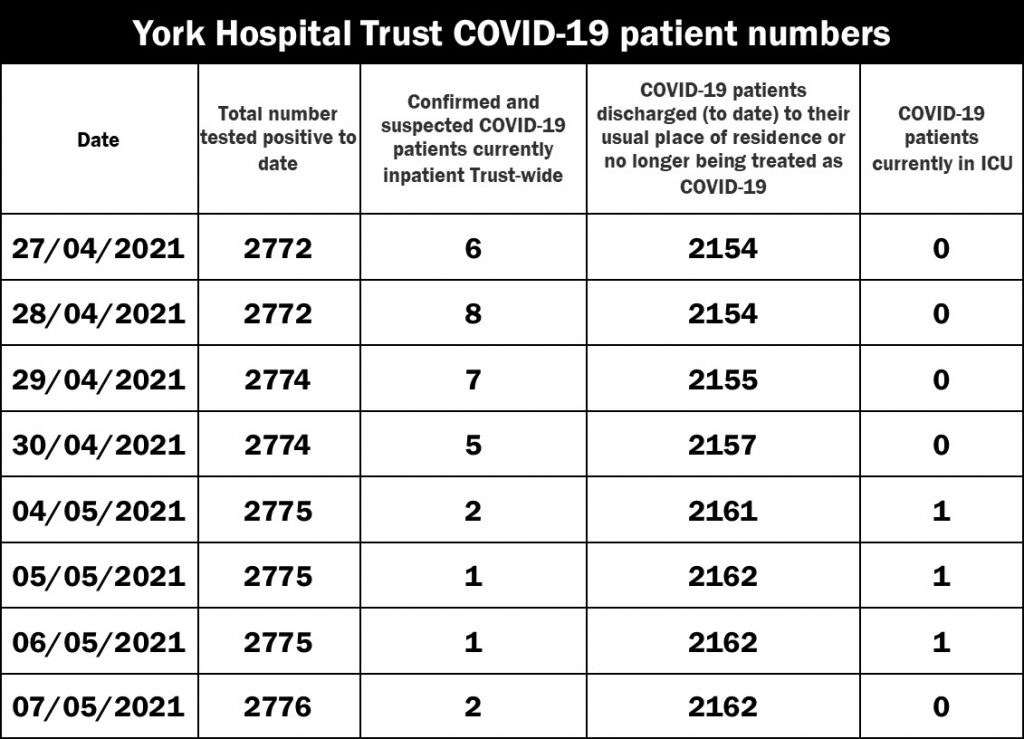
Council commentary
The York Council has updated its commentary on the pandemic. It is reproduced below for ease of access.
The data is accurate as at 8.00 a.m. on Friday 07.05.21. Some narrative for the data covering the latest period is provided here below:
People with Covid Symptoms
• NHS Pathways/111 triages – as at 3.5.21 there had been 102 total covid triages in the CYC area in the last 7 days. The peak number of triages was 653 in the 7 day period to 20.9.20.
• As at 6.5.21, the Covid Symptom App estimates 109 per 100,000 in York with symptomatic covid (responses from a sample of 3,801 people). The peak rate was 1,283 on 7.1.21.
Diagnosed cases
• As at 7.5.21 York has had 12,297 cases since the start of the pandemic, a rate of 5,839 per 100,000 of population. The cumulative rate in York is below the national (6,874) and regional (7,189) averages. Cases identified through Lateral Flow Tests will be removed if they have a negative follow up PCR test within 72 hours so the cumulative total of cases can, on occasions, go down.
• The PHE ‘Exceedance’ rating compares the no. of new cases over a 14 day period with the previous 6 weeks and provides a RAG rating to indicate if the previously observed trend in the number of new cases is worsening. The latest rating for York (3.5.21) is Red. In recent weeks the number of cases have been low in York which has an effect on the thresholds used to determine the RAG rating – a small change can mean the difference between a red, amber and green rating.
• The provisional rate of new Covid cases per 100,000 of population for the period 28.4.21 to 4.5.21 in York is 15.7 (33 cases). (Using data published on Gov.uk on 6.5.21).
• The latest official “validated” rate of new Covid cases per 100,000 of population for the period 25.4.21 to 1.5.21 in York was 18.5 (39 cases). The national and regional averages at this date were 22.5 and 44.1 respectively (using data published on Gov.uk on 6.5.21).
• York is currently ranked 72nd out of 149 Upper Tier Local Authorities (UTLAs) in England with a rank of 1 indicating the lowest 7 day rate.
• For the 7 day period 24.4.21.to 30.4.21, 1 ward (Heworth) had seen a statistically significant fall in rates compared with the 7 day period 17.4.21 to 23.4.21. For the remaining wards there had been no significant change. The number of cases in each ward varied from 0 to 7 and rates varied from 0 to 72 per 100,000. 6 wards had zero cases.
• The rate of new Covid cases per 100,000 of population for the period 25.4.21 to 1.5.21 for people aged 60+ in York was 6.1 (3 cases). The national and regional averages were 7.8 and 12.9 respectively.
• As at 4.5.21, the latest 7 day positivity rate in York (Pillar 2 PCR tests only) was 1.11%. The national and regional averages are 1.0% and 2.4% respectively.
• As at 4.5.21 the latest 7 day positivity rate in York (Pillar 2 Lateral Flow Tests only) was 0.08%. The national and regional averages are 0.1% and 0.2% respectively.
• As at 4.5.21 the latest 7 day positivity rate in York (Pillar 1 tests only) was 0.1%. The national average is 0.4%.
• As at 30.4.21 York University reported 3 individuals within the University community who was currently self-isolating because they have had a positive COVID-19 test. The peak number was 331 on the 19.10.20.
• As at 3.5.21 York St. John reported 3 individuals within the University community who were currently self-isolating because they have had a positive COVID-19 test. The peak number was 82 on the 8.10.20.
Contact Tracing
• Since 28.5.20 a total of 11,413 confirmed CYC Covid cases have been uploaded into the NHS Test and Trace system and 10,311 (90.3%) of the cases have been completed (compared with 86.6% nationally). 26,777 ‘contacts’ of these cases have been identified and 20,332 (75.9%) of these have been completed (compared with 81.2% nationally).
• Local Contact Tracing. Between 10.3.21 and 30.4.21, 180 referrals had been actioned by the local contact tracing service. Of the referrals actioned, 167 (92.8%) were successful and 13 (7.2%) were unable to be reached via phone or home visit, but guidance leaflets were posted where possible. (NB on the 10.3.21 the local CYC team became responsible for contacting all cases rather than just those that the national team could not contact).
Cases in Residential Care Settings
• As at 6.5.21 there was 1 care home in the CYC area with confirmed Covid-19 infection (at least 1 case of either a staff member or resident).
• The latest ‘outbreak’ (2+ cases) in a residential care setting in York were reported by PHE on 25.2.21 (1 home).
Cases amongst School Aged Children
• In the 7 days up to 3.5.21 there were 4 children of primary or secondary school age who tested positive (across 4 different schools).
COVID Bed Occupancy in York Hospital
• As at 4.5.21 there were 0 confirmed Covid-19 patients in General and Acute beds. The peak number was 157 on 19.1.21.
• As at 4.5.21 there was 1 confirmed Covid-19 patient and 0 suspected Covid-19 patients in the Intensive Treatment Unit. The peak number for people in ITU was 19 on 10.5.20.
• As at 4.5.21 there had been 0 patients admitted with suspected Covid-19 and 0 with confirmed Covid-19 in the previous 24 hours.
• As at 4.5.21 there had been 0 confirmed patients discharged with COVID-19 in last 24 hours.
R Number
• The ‘R’ value (the number of people that one infected person will pass on a virus to, on average) for the North East and Yorkshire area on 30.4.21 was estimated to be in the range 0.8 to 1.0. The previous estimate was (0.7 to 1.0) on 23.4.21.
Total Vaccinations
• As at 5.5.21 a total of 102,323 CYC residents have had the first dose of the vaccine. This represents 48.6% of the estimated total population of York and 58.8% of the estimated adult (18+) population of York.
• As at 5.5.21 a total of 49,913 CYC residents have had both doses of the vaccine. This represents 23.7% of the estimated total population of York and 28.7% of the estimated adult (18+) population of York.
Deaths
The two sources about deaths from Covid-19 at LA level are ONS data and local registrar data. They are derived from the same source (civil registration data). ONS data is more comprehensive as it includes deaths of York residents which have occurred and been registered outside York. Local registrar data provides a breakdown by age and gender. The most recently available data is summarised below:
• ONS Weekly data: In the most recent period (Week 16: 17.4.21 to 23.4.21) 0 Covid-19 deaths were recorded as having occurred for CYC residents. In weeks 13, 14 and 15 there had been 2, 0 and 2 deaths respectively.
• ONS Cumulative data: Since the start of the pandemic, for deaths occurring up to 23rd April 2021 and registered up to 1st May 2021, 395 Covid-19 deaths were recorded as having occurred for CYC residents (228 in hospital, 135 in care homes, 24 at home/elsewhere and 8 in a hospice). The number of deaths per 100,000 of population in York is 187.54 which is lower than the national average of 231.27
• Age / Gender breakdown (using registrar data): The average age of the CYC residents who died was 82.1, with an age range of 44-104. The age profile of the CYC residents who have died is older than the national average (79.5% were aged 75+ compared with 73.1% nationally). 48% of the CYC residents who died were male. The national average is 54.3%.

